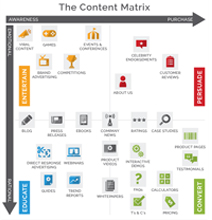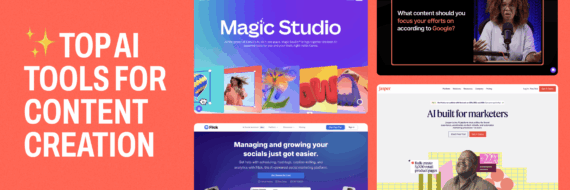The Content Matrix
 In an “educational” article by Hannah Smith at Distilled.com, 4 Types of Content Every Site Needs, the author places emphasis on four main types of content—content that entertains, educates, persuades, and converts. Here, Smith shares The Content Matrix (original concept by First 10 and Smart Insights), which provides a comprehensive summary of the types of content and where they fall in terms of customer behaviors. When you get to know the types of content possible, decide what your content is intended to do, and align it with your customer’s behaviors, what you write and where to place it begins to make a lot more sense. This brilliant approach to content is a great first step in determining and writing for blog and content categories.
In an “educational” article by Hannah Smith at Distilled.com, 4 Types of Content Every Site Needs, the author places emphasis on four main types of content—content that entertains, educates, persuades, and converts. Here, Smith shares The Content Matrix (original concept by First 10 and Smart Insights), which provides a comprehensive summary of the types of content and where they fall in terms of customer behaviors. When you get to know the types of content possible, decide what your content is intended to do, and align it with your customer’s behaviors, what you write and where to place it begins to make a lot more sense. This brilliant approach to content is a great first step in determining and writing for blog and content categories.Deciding On Content
You may have a new awareness of content types, your customer-facing intentions, and your audience’ behaviors, but after all of that you still have the same goal as most organizations: to engage readers, gain leads, and create loyal customers. So, whether you are writing blogs, creating a sitemap, or redesigning your website, there should be consistency in the content you craft for your audience. At a minimum, content must consist of:
- Easy, natural user flow
- Explicit headings
- Hierarchical stability
- Informative, engaging messaging
- Keyword rich phrasing
- Metadata accuracy
- Organization
- Relative embedded content / linking
- Refined user interactivity
- Sections / chunking
Plan smarter content with Slickplan
A collaborative workspace to handle all your content needs. Plan, gather and create together.
The Power of Hierarchy
 When you think about it, hierarchy is present in every aspect of today’s Internet whether in competitor search rankings, website navigation, or visually stimulating website elements. Companies want their products and services to stand out among the masses, and websites are the perfect opportunity to place your leads in front of the most important pages related to your business. You have the power to create content with structure, in every part of your website design strategy. When determining blog and content categories, use a hierarchical approach as you create content to reach your audiences. With proper planning and the right tools, you streamline your messages and find your customers through the power of hierarchy.
When you think about it, hierarchy is present in every aspect of today’s Internet whether in competitor search rankings, website navigation, or visually stimulating website elements. Companies want their products and services to stand out among the masses, and websites are the perfect opportunity to place your leads in front of the most important pages related to your business. You have the power to create content with structure, in every part of your website design strategy. When determining blog and content categories, use a hierarchical approach as you create content to reach your audiences. With proper planning and the right tools, you streamline your messages and find your customers through the power of hierarchy.



 X
X

